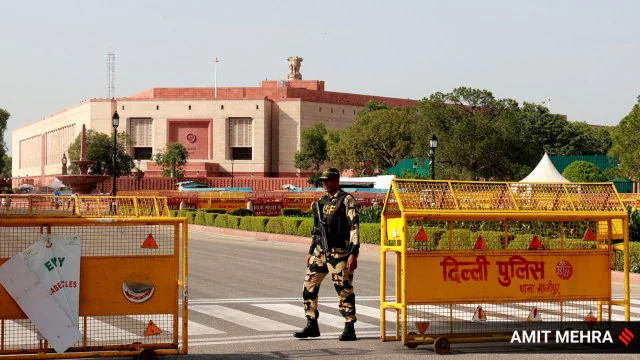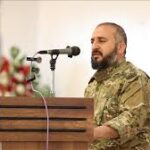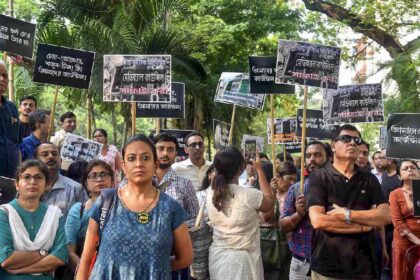Govt, Opposition Demand Debate on Operation Sindoor in Parliament’s Monsoon Session
The Indian Parliament’s Monsoon Session opened under a cloud of urgency and scrutiny, as both the government and opposition jointly demanded a detailed debate on Operation Sindoor—a high-stakes evacuation mission executed in response to the deepening regional conflict. The operation, unprecedented in its scale and political implications, has drawn both praise and concern from across the political spectrum.
Launched as a swift response to escalating hostilities in the Gulf region, Operation Sindoor was designed to bring back thousands of stranded Indian nationals, as well as citizens of neighboring countries like Nepal and Sri Lanka. The external affairs ministry touted it as a symbol of India’s diplomatic agility and humanitarian commitment. However, the secrecy surrounding its planning and the selective release of operational details have prompted opposition leaders to demand transparency. They argue that the Parliament, as the guardian of democratic accountability, must be fully apprised of the operation’s scope, strategic decisions, logistical coordination, and financial implications.
As the Monsoon Session began, the focus quickly shifted from routine legislative matters to the pressing need for an open discussion. Members of Parliament across party lines echoed the sentiment that national security cannot be divorced from democratic oversight. The debate’s demand came not as a partisan maneuver, but as a consensus-driven effort to ensure that large-scale foreign operations are executed with both effectiveness and constitutional accountability.
External Affairs Minister S. Jaishankar’s preliminary address to the Lok Sabha outlined the broad contours of the mission. He confirmed that over 12,000 individuals had been safely evacuated over a span of eight days, involving airlifts, naval support, and diplomatic clearances across five jurisdictions. While he labeled the mission a “strategic and moral success,” he also invited lawmakers to contribute to a more detailed deliberation in the coming days. His assurance did little to silence calls for a structured debate, with the opposition pointing out operational lapses, including delays in issuing advisories and inconsistencies in evacuation prioritization.
At the heart of the debate lies the broader question of India’s evolving doctrine in regional emergencies. Operation Sindoor is not just a rescue operation—it is a case study in the use of state power abroad, the limits of soft diplomacy, and the logistics of multinational humanitarian coordination under fire. The Parliament’s response, therefore, is about more than retrospective justification—it is about setting norms for future engagements.
This parliamentary session, consequently, is not merely another procedural cycle. It is a defining moment in India’s foreign and domestic political alignment—one where the lines between humanitarian obligation and geopolitical assertion blur, and where Parliament’s voice could shape not only the legacy of Operation Sindoor but also the template for India’s future external interventions.
As the Monsoon Session progressed, the demand for a detailed and transparent debate over Operation Sindoor grew louder. In both the Lok Sabha and the Rajya Sabha, MPs from various parties stood united in pressing for clarity on the government’s actions. While the ruling party emphasized national security concerns and the need for swift action in volatile regions, opposition leaders insisted on parliamentary oversight and a comprehensive briefing on the motives, execution, and diplomatic consequences of the operation.
Congress, Trinamool Congress, and DMK MPs coordinated floor strategies, staging walkouts and raising slogans demanding a full-fledged discussion. They questioned the lack of prior consultation, the absence of a published evacuation protocol, and the potential fallout on India’s relationships with Iran, Israel, and the Gulf countries. The question dominating the debate was simple yet pressing: Did Operation Sindoor reflect a strategic shift in India’s foreign policy, or was it a rushed response to a geopolitical emergency?
Bharatiya Janata Party (BJP) leaders, including Union Ministers, countered these accusations by highlighting the success of the evacuation—over 1,000 Indian nationals, along with Nepali and Sri Lankan citizens, were safely airlifted from conflict zones. They praised the coordination between the Ministry of External Affairs (MEA), Indian Air Force (IAF), and diplomatic missions. Prime Minister Narendra Modi remained tight-lipped during Question Hour but later addressed the issue indirectly during his remarks on India’s global responsibilities.
Television newsrooms mirrored the drama unfolding inside Parliament. Pundits dissected every statement, while reporters lined up outside ministries seeking comment. Hashtags like #OperationSindoor, #IndiaEvacuates, and #MonsoonDebate trended across social media platforms. Think tanks and retired diplomats added their perspectives, some praising the swift execution while others expressed concern over long-term diplomatic repercussions.
A particularly contentious moment occurred when Shiv Sena (UBT) MP Priyanka Chaturvedi questioned the timing of the operation, suggesting it was politically motivated and intended to deflect attention from domestic issues such as inflation and unemployment. Her remarks were met with sharp rebuttals from Treasury benches, leading to a brief adjournment of the House.
Meanwhile, in the backrooms of South Block, bureaucrats and intelligence officials were reportedly preparing confidential dossiers to brief key Parliamentary committees. Sources claimed these dossiers contained intercepted communications, strategic assessments, and coordination memos between India and foreign governments. Still, the opposition maintained that such information should be made public to foster accountability.
The unfolding drama reflected more than just political sparring—it became a litmus test for India’s democratic ethos in times of global crisis. Would Parliament assert its right to debate matters of urgent national importance, or would executive decisions escape scrutiny under the banner of national interest?
In the shadowed corridors of power, far from the shouting matches of Parliament and the glaring lights of news studios, the seeds of Operation Sindoor had been sown weeks before the public ever heard the name. Top officials within the Ministry of External Affairs (MEA), National Security Council Secretariat (NSCS), and Research and Analysis Wing (RAW) had reportedly raised red flags about the worsening security situation in the Middle East, particularly after Iran’s airspace became an unpredictable variable in the larger regional conflict.
The first inklings of an evacuation plan were formed during a closed-door meeting at South Block involving high-ranking officials from the MEA, Ministry of Defence (MoD), and the Prime Minister’s Office (PMO). The operation’s codename—Sindoor—was chosen not only for its cultural symbolism of protection and commitment, but also as a strategic signal, subtly asserting India’s proactive diplomatic intent without overt provocation.
The logistical challenges were immense. Indian nationals were scattered across multiple cities, some located dangerously close to escalating conflict zones. Commercial airlines had already halted operations. Satellite imagery and intelligence intercepts confirmed increased missile activity in Iranian and Israeli airspace. The evacuation would need to be precise, swift, and deeply coordinated across military, diplomatic, and intelligence channels.
Command of the operation was reportedly given to a senior Joint Secretary in MEA with extensive West Asia experience. Air corridors were negotiated through high-stakes diplomacy, especially with Iran—a country facing its own internal security tremors and complex relations with India. The IAF deployed C-17 Globemaster III aircraft, known for their capacity and range, staging them in Oman and the UAE for rapid insertion and extraction.
On the ground, Indian embassies and consulates activated community networks, coordinating with Indian expat leaders, student associations, and business chambers. Secure mobile messaging groups and helpline numbers were established to reach those in need. Local liaisons—many of them volunteers—risked their own safety to gather evacuees at designated rendezvous points under curfews and surveillance.
Back home, a war-room within the PMO tracked every aircraft movement, every border checkpoint clearance, and every call for help. Constant communication was maintained with the Defence Minister and External Affairs Minister, who in turn provided selective updates to the Cabinet Committee on Security.
For those airlifted, the experience was both terrifying and surreal. One evacuee, speaking anonymously to a national daily, described hiding in a basement for 48 hours before being taken to a makeshift airstrip in a convoy of Indian Embassy vehicles flanked by local security. “When we finally saw the Indian flag on the aircraft, many of us wept,” the evacuee recalled.
Yet the operation was not without cost. A handful of Indian workers remained unaccounted for, with search efforts continuing through diplomatic backchannels. Additionally, coordination with Nepal and Sri Lanka to evacuate their citizens drew India into sensitive bilateral and multilateral dynamics, especially with concerns raised by Gulf States about potential political implications.
Internally, RAW operatives compiled a classified debrief outlining the security environment in which Operation Sindoor was executed. This included intelligence on regional power plays, Iranian air defense readiness, and the potential involvement of non-state actors targeting civilian corridors. That report, sources claimed, would never see the light of day—unless the political stakes forced it into public domain.
As Parliament remained engrossed in whether the executive had overstepped its mandate, those involved in the operation were already preparing a classified post-action review. India had pulled off one of its most complex civilian evacuations in recent history—but at a time when every move was under scrutiny, the true test lay in how it would be explained, justified, and remembered.
The story of Operation Sindoor was no longer just about geopolitics or foreign policy; it had become a measure of India’s institutional strength in responding to crisis, its moral compass in protecting citizens, and its democratic framework in balancing secrecy with accountability.
As Operation Sindoor unfolded, the evacuation became more than a tactical response to a geopolitical emergency—it emerged as a defining moment in India’s foreign policy doctrine. Analysts began connecting the dots between the operation and a broader realignment in India’s regional and global posture, particularly in the context of West Asia.
Traditionally, India’s diplomacy in the Middle East had walked a tightrope: maintaining cordial ties with Iran, nurturing strategic partnerships with Israel, and securing economic and labor interests in the Gulf Cooperation Council (GCC) countries. However, Operation Sindoor—executed amidst heightened military action involving Iran and Israel—was being interpreted as a subtle yet significant tilt.
While Indian officials officially denied favoring one side, critics and international observers noted the swiftness with which India coordinated with Tel Aviv and Gulf capitals, contrasted with the cautious, behind-the-scenes communication with Tehran. Foreign policy veterans, such as former ambassadors and strategic scholars, debated whether this operational balancing act signaled a transition from India’s long-practiced “strategic autonomy” to a more assertive “strategic alignment.”
Adding fuel to the discourse was India’s decision to evacuate not only its citizens but also Nepali and Sri Lankan nationals. The move, while humanitarian on the surface, projected India’s growing clout as a regional power capable of shielding South Asia from the spillover effects of Middle Eastern instability. In the corridors of multilateral diplomacy, this was read as a soft assertion of leadership—a subtle message to China, which had maintained silence during the crisis.
Meanwhile, the debate within Parliament shifted focus from the operation’s execution to its implications. Former External Affairs Minister and Congress MP Salman Khurshid questioned whether India had “crossed a Rubicon” in its relationship with Iran. “Are we prepared for the diplomatic blowback if our actions are interpreted as choosing sides?” he asked during a special briefing session. His concern was not unfounded. Iranian media outlets began publishing critical commentaries on India’s perceived silence over civilian casualties in Gaza, hinting at a frost forming behind closed doors.
Simultaneously, Israeli diplomats praised India’s efficiency and discretion, privately acknowledging the role of Indian intelligence in avoiding flight paths considered vulnerable to Iranian retaliation. Reports surfaced of encrypted communication channels opened between Indian and Israeli security agencies during the operation, a move that many in the intelligence community believed had cemented a new layer of strategic cooperation.
In the Gulf, however, reactions were more nuanced. While the UAE and Saudi Arabia welcomed India’s proactive evacuation of South Asian nationals, there were murmurs about the lack of coordination with local authorities in certain airspace negotiations. Gulf news agencies cautiously carried stories about “external interventions” and “regional responsibilities,” a nod to the delicate sovereignty balance they maintain amid external powers’ influence.
At home, the National Security Advisor (NSA) held a classified debriefing for members of the Parliamentary Standing Committee on External Affairs. The presentation, described by insiders as “brisk but vague,” outlined the timeline of Operation Sindoor, its diplomatic groundwork, and the lessons drawn for future conflict evacuations. Still, opposition MPs demanded clearer disclosures and called for a white paper to be tabled.
For the Indian public, the narrative was more emotional than strategic. Media channels continued looping images of weeping families reunited at airports, frontline officials being felicitated, and the flag-covered aircraft emerging from the dusk of warzones. In the popular imagination, Operation Sindoor was less about geopolitics and more about a simple, powerful promise: no Indian will be left behind.
But in policy circles, the underlying message was unmistakable—India was no longer merely reacting to global crises; it was shaping the rules of engagement.
Also Read : Syria Declares Ceasefire in Suwayda and Deploys Forces to Restore Security








